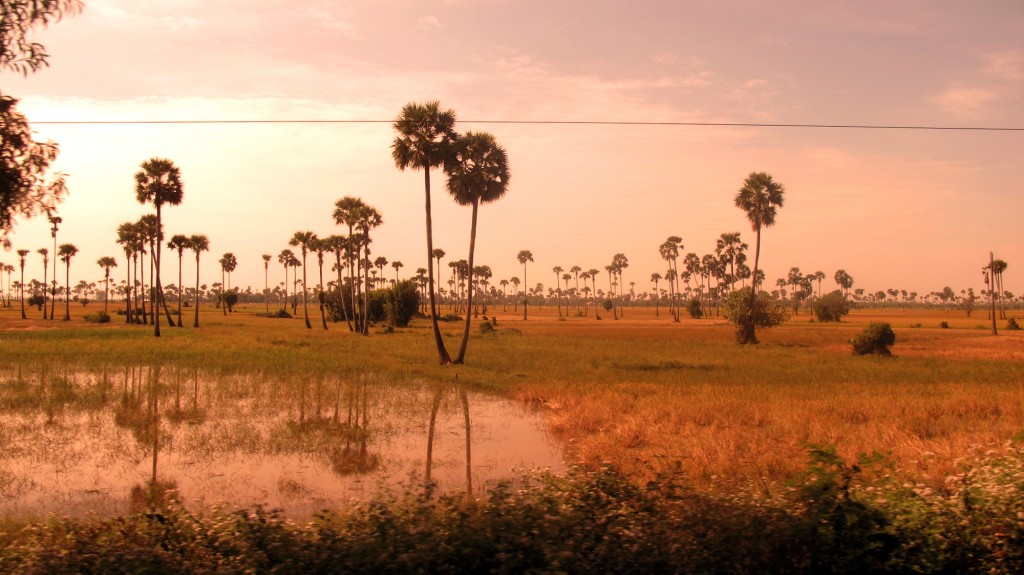
ទេសភាពតាមជនបទនៅប្រទេសកម្ពុជា រូបភាព ថតដោយ Eddy Milfort កាលពីថ្ងៃទី ១៩ ខែធ្នូ ឆ្នាំ២០១០ ។ ក្រោមអាជ្ញាប័ណ្ណ CC BY 2.0
ការជួលដីសាធារណៈ គឺជាការផ្តល់ដីរដ្ឋដល់នីតិបុគ្គលឯកជនក្នុងទម្រង់ជាកិច្ចព្រមព្រៀងជួលដែលមានកិច្ចសន្យា។ ច្បាប់កម្ពុជាបានផ្តល់ឱកាសដល់ការជួលដីរដ្ឋរយៈពេលខ្លី និងរយៈពេលវែង ទៅតាមគោលបំណង និងភតិកៈ។ ការជួលដីសាធារណៈភាគច្រើនត្រូវបានអនុញ្ញតលើដីឯកជនរបស់រដ្ឋ ដែលមិនមានផលប្រយោជន៍សាធារណៈ ឬុមិនផ្តល់សេវា ឬមុខងារសាធារណៈ។ យ៉ាងនេះក្តី ការជួលដីដែលមានលក្ខណៈរិតត្បិតខ្លាំង អាចត្រូវបានធ្វើឡើងសម្រាប់ដីសាធារណៈរបស់រដ្ឋ1 ដែលបម្រើឲ្យផលប្រយោជន៍សាធារណៈ។ ការជួលដីសាធារណៈ ជាពិសេស សម្បទានដីធ្លី តែងតែពាក់ព័ន្ធនឹងជម្លោះដីធ្លី ដូចដែលត្រូវបានរាយការណ៍ដោយអង្គការមិនមែនរដ្ឋាភិបាល ប្រព័ន្ធផ្សព្វផ្សាយ និងអង្គការសហប្រជាជាតិ។2
ក្របខ័ណ្ឌគោលនយោបាយនិងច្បាប់
ក្របខ័ណ្ឌគតិយុត្តិពាក់ព័ន្ធនឹងការជួលដីសាធារណៈ មានលក្ខណៈទូលាយខ្លាំង និង ស្មុគស្មាញ។ ភាគច្រើននៃក្របខ័ណ្ឌ និងនីតិវិធីទាំងនេះ បើទោះជាមិនទាំងអស់ មានចែងក្នុងច្បាប់ភូមិបាល ឆ្នាំ ២០០១ និងអនុក្រឹត្យជាច្រើនផ្សេងទៀត ដែលគ្រប់គ្រងការជួលដោយឡែកៗពីគ្នា។ ក្រៅពីនេះ ការជួលជាច្រើនត្រូវអនុលោមតាមបទប្បញ្ញត្តិសំខាន់ៗក្នុងច្បាប់ស្តីពីព្រៃឈើ ច្បាប់ស្តីពីបរិស្ថាន និងច្បាប់ស្តីពីតំបន់ការពារ ដែលបានកំណត់សិទ្ធិរបស់ប្រភេទដីធ្លីមួយចំនួន និងក្រុមមនុស្សមួយចំនួន ព្រមទាំងច្បាប់ស្តីពីវិនិយោគ ផងដែរ។
រដ្ឋាភិបាលកម្ពុជាបានព្យាយាមប្រើប្រាស់ការជួលដីសាធារណៈ ជាមធ្យោបាយក្នុងការជំរុញការវិនិយោគលើវិស័យកសិឧស្សាហកម្ម ពាណិជ្ជកម្ម និងហេដ្ឋារចនាសម្ព័ន្ធ។ ការណ៍នេះ មានគោលបំណងបង្កើនការអភិវឌ្ឍសេដ្ឋកិច្ច និងសមាហរណកម្មទៅក្នុងសេដ្ឋកិច្ចតំបន់ តាមរយៈកំណើនផលិតភាព ឱកាសការងារ និងឱកាសបង្កើតប្រាក់ចំណូល។3 យ៉ាងនេះក្តី គោលនយោបាយថ្មីៗរបស់រដ្ឋាភិបាលបានងាកមកផ្តោតលើការផ្តល់ដីធ្លីដល់ប្រជាជនគ្មានដី សម្រាប់ជាមធ្យោបាយនៃការកាត់បន្ថយភាពក្រីក្រ។4
សម្បទានដី
ការជួលដីសាធារណៈមានច្រើនប្រភេទខុសៗគ្នា ដែលភាគច្រើនគឺសម្បទាន ។ សម្បទានគឺជាការផ្តល់សិទ្ធិកាន់កាប់លើតំបន់មួយសម្រាប់គោលបំណងជាក់លាក់មួយ។ ច្បាប់ភូមិបាលឆ្នាំ ២០០១ បានកំណត់ដីសម្បទានជា ៣ ប្រភេទ ៖ ដីសម្បទានសេដ្ឋកិច្ច (ELCs) ដីសម្បទានសង្គមកិច្ច (SLCs) និងដីសម្បទានផ្សេងទៀត។5 ក្របខ័ណ្ឌគតិយុត្តិសម្រាប់ប្រភេទដីសម្បទានខាងក្រោយនេះ ភាគច្រើនមិនទាន់ត្រូវបានតាក់តែងឡើងនៅឡើយ។6 សម្បទានដីសេដ្ឋកិច្ច គឺជាការជួលដីរយៈពេលវែងរហូតដល់ ៩៩ ឆ្នាំ សម្រាប់វិស័យកសិឧស្សាហកម្ម។7 ដោយប្រឈមនឹងការចោទប្រកាន់ជាច្រើនពីសហគមន៍ អង្គការមិនមែនរដ្ឋាភិបាល និង អង្គការហប្រជាជាតិ ពីការទន្ទ្រានយកដី ការវាតទីដីព្រៃ និងបញ្ហាបរិស្ថាន ការផ្តល់ដីសម្បទានសេដ្ឋកិច្ចថ្មីត្រូវបានផ្អាកនៅឆ្នាំ ២០១២ ហើយដីសម្បទានសេដ្ឋកិច្ចដែលមានស្រាប់កំពុងស្ថិតក្រោមការពិនិត្យឡើងវិញ។8 ដីសម្បទានសង្គមកិច្ចបម្រើឲ្យផលប្រយោជន៍សង្គម និងអនុញ្ញាតឲ្យអនុប្បទានិកសាងសង់លំនៅដ្ឋាន ឬដាំដំណាំលើដីរដ្ឋ ដើម្បីចិញ្ចឹមជីវិត។ ខុសពីការជួលដីសាធារណៈផ្សេងទៀត ដីសម្បទានសង្គមកិច្ចអាចត្រូវបានផ្លាស់ប្តូរទៅកម្មសិទ្ធិក្រោយពីរយៈពេល ៥ ឆ្នាំ នៃការបន្តប្រើប្រាស់ និងអនុលោមតាមលក្ខខណ្ឌនានា ។9
តំបន់សេដ្ឋកិច្ចពិសេស
តំបន់សេដ្ឋកិច្ចពិសេស (SEZs) សំដៅលើតំបន់កំណត់ជាក់លាក់មួយនៅក្នុងប្រទេសដែលត្រូវអនុលោមតាមបទប្បញ្ញត្តិផ្សេងៗពីតំបន់ដទៃទៀតក្នុងនៅប្រទេស។ តំបន់ឧស្សាហកម្មធំៗទាំងនេះ ផ្តល់ការលើកទឹកចិត្តអនុគ្រោះដល់វិនិយោគិន និងផ្តល់ការគាំទ្រផ្នែករដ្ឋបាលលើកិច្ចការនាំចេញ-នាំចូលពីរដ្ឋាភិបាល ដើម្បីទាក់ទាញការវិនិយោគបរទេស ពង្រឹងការប្រកួតប្រជែងសកល និងលើកកំពស់ការអភិវឌ្ឍសេដ្ឋកិច្ច។10 នៅតំបន់នេះ នីតិបុគ្គលឯកជនអភិវឌ្ឍតំបន់ និងហេដ្ឋារចនាសម្ព័ន្ធរបស់ពួកគេ ហើយពួកគេជួលទីតាំងក្នុងតំបន់សេដ្ឋកិច្ចពិសេសនោះ ទៅឲ្យវិនិយោគិន។11 តំបន់សេដ្ឋកិច្ចពិសេសស្ថិតក្រោមអភិបាលកិច្ចរបស់ក្រុមប្រឹក្សាអភិវឌ្ឍន៍កម្ពុជា (CDC) ក្រោមច្បាប់វិនិយោគ និងអនុក្រឹត្យលេខ ១៤៨។
ដីសាធារណៈរបស់រដ្ឋ
ក្រៅពីនេះ ដីសាធារណៈរបស់រដ្ឋ អាចត្រូវបានជួល ប៉ុន្តែការជួលនោះត្រូវប្រឈមនឹងការរិតត្បិតតឹងតែងជាងការជួលដីឯកជនរបស់រដ្ឋ។ ដីសាធារណៈ អាចត្រូវបានជួលសម្រាប់រយៈពេលមិនលើសពី ១៥ ឆ្នាំ ហើយដីនោះត្រូវបន្តផ្តល់សេវា ឬមុខងារសាធារណៈ។12 យ៉ាងនេះក្តី ដីធ្លីតែងតែត្រូវបានធ្វើចំណាត់ថ្នាក់ឡើងវិញ ជាដីឯកជនរបស់រដ្ឋដើម្បីសម្របសម្រួលដល់ការជួល ជាដំណើរការមួយ ដែលអាចធ្វើឡើងតែតាមផ្លូវច្បាប់ប៉ុណ្ណោះ ប្រសិនបើដីសាធារណៈរបស់រដ្ឋ លែងបម្រើផលប្រយោជន៍សាធារណៈ។13
ដីធ្លីក៏អាចត្រូវបានជួលរួមគ្នាទៅឲ្យសហគមន៍ និងជនជាតិដើមភាគតិចក្នុងទម្រង់ជាព្រៃហគមន៍ ឬតំបន់សហគមន៍ការពារ។ ការជួលទាំងពីរមានរយៈពេលរហូតដល់ ១៥ ឆ្នាំ និងតម្រូវឲ្យមានការប្រើប្រាស់ និងគ្រប់គ្រងដីនោះប្រកបដោយនិរន្តរភាព ក្រោមក្របខ័ណ្ឌនៃផែនការប្រើប្រាស់ដីធ្លី ដែលបានព្រមព្រៀងគ្នា។14
ទាក់ទងនឹងការជួលដីសាធារណៈ
បច្ចុប្បន្នភាពចុងក្រោយ៖ ១ វិច្ឆិកា ២០១៥
ឯកសារយោង
- 1. ច្បាប់ភូមិបាល ឆ្នាំ២០០១, មាត្រា១៦-១៨។
- 2. មើល អង្គការ អាដហុក (ឆ្នាំ២០១៤). “ស្ថានភាពដីធ្លី ឆ្នាំ២០១៣.” https://opendevelopmentcambodia.net/dataset/?id=land-situation-in-cambodia-2013-1 ។ ម៉ៃ ទិត្យថារ៉ា. ឆ្នាំ២០១៥. “សហគមន៍ជម្រុញឱ្យរដ្ឋាភិបាលលុបចោលសម្បទានដីសេដ្ឋកិច្ច.” ភ្នំពេញ ប៉ុស្តិ៍ ថ្ងៃទី ៥ ខែកុម្ភៈ. http://www.phnompenhpost.com/communities-urge-govt-rescind-elcs ។ ការិយាល័យឧត្តមស្នងការអង្គការសហប្រជាជាតិទទួលបន្ទុកសិទ្ធិមនុស្ស. ឆ្នាំ២០១២. “ការបណ្តេញចេញ និងការតាំងលំនៅជាថ្មី នៅកម្ពុជា៖ “តម្លៃមនុស្ស ផលប៉ះពាល់ និងដំណោះស្រាយ.” អង្គការសហប្រជាជាតិ.http://cambodia.ohchr.org/WebDOCs/DocProgrammes/Resettlement_Study-28_Feb_2012_Eng.pdf ។
- 3. ផែនការយុទ្ធសាស្រ្តអភិវឌ្ឍន៍ជាតិ: ឆ្នាំ២០០៩-ឆ្នាំ២០១៣. http://www.hacccambodia.org/download_pub.php?file=NSDP%202009-2013.pdf ។
- 4. ផែនការយុទ្ធសាស្រ្តអភិវឌ្ឍន៍ជាតិ: ឆ្នាំ២០១៤-ឆ្នាំ២០១៨. http://countryoffice.unfpa.org/cambodia/drive/NSDP2014-2018.pdf ។
- 5. ច្បាប់ភូមិបាល ឆ្នាំ២០០១, មាត្រា៤៩-៥០។
- 6. ច្បាប់ស្តីពីសម្បទាន ឆ្នាំ២០០៧ គ្រប់គ្រងសម្បទានហេដ្ឋារចនាសម្ព័ន្ធ។ ច្បាប់ស្តីពីការគ្រប់គ្រងធនធានរ៉ែ ឆ្នាំ២០០១ អភិបាលលើសម្បទានរ៉ែ។ ច្បាប់ស្តីពីជលផល ឆ្នាំ២០០៦ អនុវត្តលើសម្បទានជលផល។
- 7. អនុក្រឹត្យលេខ ១៤៦ ស្តីពីសម្បទានដីសេដ្ឋកិច្ច។
- 8. បទបញ្ជាលេខ ០១ ស្តីពីវិធានការពង្រឹង និងបង្កើនប្រសិទ្ធភាពការគ្រប់គ្រងសម្បទានដីសេដ្ឋកិច្ច (ឆ្នាំ២០១២). www.mlmupc.gov.kh/mlm/imgs/20130213%20Manual%20for%20Implementing%20Govt%20Order%2001_ENG.pdf ។
- 9. អនុក្រឹត្យ លេខ១៩ ស្តីពីសម្បទានដីសង្គមកិច្ច។
- 10. អនុក្រឹត្យ លេខ ១៤៨ ស្តីពីការបង្កើត និងការគ្រប់គ្រងតំបន់សេដ្ឋកិច្ចពិសេស។
- 11. ដូចខាងលើ។
- 12. អនុក្រឹត្យ លេខ ១២៩ ស្តីពីវិធាន និងនីតិវិធី លើការធ្វើចំណាត់ថ្នាក់ទ្រព្យរបស់រដ្ឋ និងគ្រឹះស្ថានសាធារណៈរបស់រដ្ឋ, មាត្រា១៦-១៨។
- 13. ព្រះរាជក្រឹត្យ លេខ ៣៣៩ (ឆ្នាំ២០០៦), មាត្រា៣។
- 14. ច្បាប់ស្តីពីព្រៃឈើ ឆ្នាំ២០០២។ ច្បាប់ស្តីពីតំបន់ការពារ ឆ្នាំ២០០៨។

